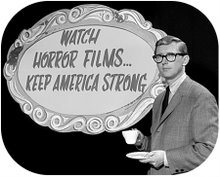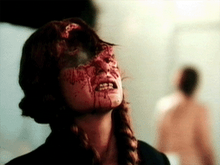It's time for our third hit off that Deathstalker supply, which, unlike THC, will still be legal in Texas come September (though maybe not legal in school libraries). (Yeah, I'm writing this post at work.) This third Deathstalker movie also features a third actor playing the title role (though original Deathstalker Rick Hill would return to the fold for the fourth straight-to-video installment in 1991) but otherwise sticks to the sword and sorcery formula of the first film, dialing the second film's intentional humor way down. Up against the stylish, goofy, and pizzazz-filled action of the first two Deathstalkers, Warriors from Hell is a bit of a letdown, but it has its moments.
Opening with what can only be described as $2 Renaissance Faire, our new Deathstalker (John Allen Nelson, less of a beefcake than his two predecessors but retaining John Terlesky's frat boy look) is hanging out with some villagers in a field, sparring with a buddy on ye olde balance beame while his elderly wizard friend Nicias (Aaron Hernan) tells fortunes for some coinage. A hooded figure arrives and asks Nicias for a private convo in his tent. This figure is a princess, Carissa (Carla Herd). Carissa is yet another princess whose family castle and throne have been usurped by an evil sorcerer, in this case Troxartas (Thom Christopher), but Carissa has a plan. She's got a chunk of magic stone, and she needs to find the other chunk. When she puts the magic stone pieces together, kablammo! Evil is vanquished and a lost city appears. She's been given some erroneous information that Nicias has the other piece, but Nicias regrets to inform her that Troxartas has it.
When people start talking about magic stones, my general response is, "who gives a shit?," but if these magic stones lead to good times, I'll allow it. While this magic stone tent meeting is happening, Troxartas' men ride up on horseback with their special masked helmets that look like bat wings ("da-na-na-na-na-na-na-na, bat mask") and start kicking villager ass. Nicias tells Deathstalker to save Carissa, and he'll distract the baddies with some wizard magic, which involves spinning around at incredible speed for a minute and then disappearing in a puff of smoke, leaving his footwear behind for some reason. The rest of his clothes are magically allowed to remain with the body.
Deathstalker and Carissa get away and camp out in the woods. Despite Deathstalker's offer to share the blankets, Carissa decides to spend the night in her own tent. Fatal mistake. Troxartas' bat boys catch up to them and fatally wound Carissa. Before she dies, she gives him the magic stone piece. Deathstalker is now determined to avenge Carissa and smush them damn stones together at Troxartas' place.
Deathstalker escapes the horde yet again and hits the road, sans horse. Passing a hillside cottage and barn, he attempts to "borrow" one of the horses on the property but is thwarted by the two women who live there, a potato-loving semi-crone with wild frizzy hair and her sexy daughter Marinda (Claudia Inchaurregui), and their bow and arrow skills. When Marinda pats Deathstalker down for weapons, she becomes mesmerized by Deathstalker's crotch. She gazes into it intensely for an extended period of time, like she's trying to find Waldo. Sensing the mood changing, Deathstalker gives a sanitized spiel of recent events, flashes the magic stone, and tells them he'll be back with hundreds of these stones if he can borrow a horse.
The women invite him to spend the night, but Mom, disapproving of the way her daughter has been checking out the goods, tells him he'll have to sleep in the barn. They have a potato meal with extra potato, and Deathstalker politely tells the ladies he'll catch them a rabbit for breakfast. This makes the older woman furious: "Rabbit? In this house, we eat potatoes!" Ah, I can't stay mad at this delightful lunatic.
Marinda, tired of being a sexy adult woman stuck sleeping in a bed with her insane mother and eating potatoes for every meal, sneaks into the barn for some erotic good times and great oldies with Deathstalker. Troxartas' bat dicks show up yet again, and Marinda's mother, noticing her daughter is not in the bed and putting two and two together, leads them to the barn. Too late. Marinda helps Deathstalker escape, and they plan to meet up later for more sexy times after the magic stone quest is done.
On the road to Troxartas (a fun name to hear and to say), Deathstalker gets tangled up with yet another princess, the spoiled and sassy Elizena, who happens to be Carissa's sister. She's also played by Carla Herd. More on that freak later. Elizena is also on her way to Troxartas because their marriage has been arranged. Carissa was hipper to Troxartas' evil ways, but Elizena is a shallow and materialistic woman who just wants to live in a castle and have power again. She's unaware that Troxartas just wants her for the magic stone. He's no fan of the ladies.
About that. Troxartas' servant/assistant is an attractive woman named Camisarde (Terri Treas). She's hot for Troxartas and repeatedly tries and fails to bust a move with the sorcerer. He tells her that the feeling is mutual, but he's far too busy trying to get the other half of the stone, increase his magic powers, and raise an army of warriors from the dead to do the wild thing. Camisarde is not picking up the signals that Troxartas is laying down, not even when he camps it up in the basement crypt in celebration after he successfully reanimates the dead warriors. (One of these reanimated warriors has the funniest and best line deliveries in the whole movie and steals every scene he's in. The guy rules. I wish I knew his character's name to give him full credit.) Don't feel bad, Camisarde. Elizena is equally clueless even when Troxartas pulls up on horseback in the countryside to escort her to the castle dressed like Little Edie from Grey Gardens with a hint of Freddie Mercury. You're never getting laid, Camisarde.
Eventually, everyone's at the castle and we get wizards, sorcery, battles, pratfalls, magic stone shenanigans, and swordfights, including one of the most bizarre and baffling swordfights I've ever seen between Deathstalker and Troxartas that looks like a cross between a poorly choreographed erotic modern dance performance and a Laurel and Hardy routine.
You'll notice I haven't been saying much about the filmmaking. This third installment in the franchise looks more like television than cinema and is the least visually appealing of the three. I'm not saying the first two Deathstalker movies are wonderlands of visual invention, but they do have some of the ol' razzle-dazzle. The visual style of this movie is basically just to film the script without putting any fucking fairy dust over the bastard, to paraphrase the Troggs tapes. It's a mildly entertaining movie, but it's not as much nonstop fun as the first two.
I said I'd get back to Carla Herd, the woman who played both princesses. Her acting career was short, lasting from the late 1980s to the early 1990s. She appeared in one other film, the low-budget action movie Wild Zone, and had a one-year recurring role on the soap opera The Bold and the Beautiful. Her other credits include episodes of Houston Knights, 1st & Ten, and Monsters. Unless you're a b-movie aficionado, you probably know Carla Herd by her married name, Carla Sands. She married real estate and investment company CEO Fred Sands and took over as CEO after his death. She's also a hardcore MAGA nut whose massive campaign contributions to Trump led to her becoming one of his economic advisors and eventually ambassador to Denmark in Trump's first term. She also unsuccessfully ran for Senate in her home state of Pennsylvania, coming in fourth in the Republican primary that Dr. Oz won. She falsely claimed her vote wasn't counted and that she was disenfranchised, which was disproved by the New York Times. Her ambassadorship included numerous Hatch Act violations, but because we live in MAGA world, nothing happened. She likes to tweet and say stupid shit, including that Danes can't afford cars and have to bike everywhere, a nightmare she claimed Biden would bring to this country ("the horror, the horror"), and that the U.S. should aggressively take Greenland from Denmark. Needless to say, I'm glad Deathstalker didn't end up with Elizena at the end of this thing.






































